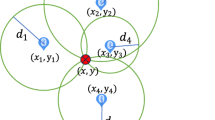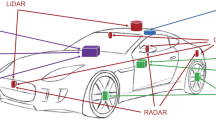Abstract
Wireless sensor networks (WSNs) are a necessary technology for the development of ambient intelligence (AmI) applications. One of the major concerns of designing WSNs for AmI applications is the localization of the sensor nodes. This paper proposes a new range-free localization algorithm for large-scale WSNs using received signal strength (RSS) measurements. Different from most RSS-based range-free localization in WSNs, the proposed two-stage weighted centroid localization (TS-WCL) algorithm utilizes the RSS measurements between pairs of anchors, except for the RSS measurements between the unknown node and anchor nodes. In the first stage of TS-WCL, the unknown node constructs a virtual neighboring anchor list by doing half-symmetric lens presence tests. A half-symmetric lens presence test determines a residence area of the unknown node using the locations of two neighboring anchors and the corresponding RSS measurements. The centroid of the estimated residence area is then regarded as a virtual neighboring anchor of the unknown node. In the second stage, a weighted centroid formula is used to estimate the location of the unknown node based on the virtual neighboring anchor list. Simulation results show that the proposed method has better performance compared to other three typical range-free localization methods.










Similar content being viewed by others
References
Atmojo UD, Salcic Z, Wang IK, Park H (2015) System-level approach to the design of ambient intelligence systems based on wireless sensor and actuator networks. Journal of Ambient Intelligence Humanized Computing 6:1–17
Bahl P, Padmanabhan VN (2000) RADAR: An in-building RF-based user location and tracking system. In: Proceedings Joint Conference IEEE Computer and Communications Societies, pp 775–784.
Blumenthal J, Grossmann R, Golatowski F, Timmermann D (2007) Weighted centroid localization in Zigbee-based sensor networks. In: Proceedings of IEEE International Symposium on Intelligent Signal Processing, pp 1–6
Bo C, Ren D, Tang S, Li XY, Mao X, Huang Q, Mo L, Jiang Z, Sun Y, Liu Y (2012) Locating sensors in the forest: A case study in Green Orbs. In: Proceedings of IEEE International Conference on Computer Communications, pp 1026–1034
Bruckner D, Picus C, Velik R, Herzner W, Zucker G (2012) Hierarchical semantic processing architecture for smart sensors in surveillance networks. IEEE Trans Industrial Informatics 8(2):291–301
Bulusu N, Heidemann J, Estrin D (2000) GPS-less low cost outdoor localization for very small devices. IEEE Personal Commun Mag 7(5): 28–34
Chang H, Tian J, Lai T, Chu H, and Huang P (2008) Spinning beacons for precise indoor localization. In: Proceedings ACM Conference on Embedded Network Sensor Systems, pp 127–140
He T, Huang C, Blum BM, Stankovic JA, Abdelzaher TF (2003) Range-free localization schemes for large scale sensor networks. In: Proceedings of International Conference on Mobile Computing and Networking, pp 81–95
Hofmann-Wellenhof B, Lichtenegger H, Collins J (1997) Global positioning system: theory and practice. Springer, New York
Iqbal M, Lim HB, Wang W, Yao Y (2008) A sensor grid infrastructure for large-scale ambient intelligence. In: Proceedings of International Conference on Parallel and Distributed Computing, Applications and Technologies, pp 468–473
Kulkarni RV, Forster A, Venayagamoorthy GK (2011) Computational intelligence in wireless sensor networks: a survey. IEEE Communications Surveys Tutorials 13(1):68–96
Lasla N, Younis MF, Ouadjaout A, Badache N (2015) An effective area-based localization algorithm for wireless networks. IEEE Trans Computers 64(8):2103–2118
Liu C, Scott T, Wu K, Hoffman D (2007) Range-free sensor localization with ring overlapping based on comparison of received signal strength indicator. Int J Sensor Networks 2(5):399–413
Mao G, Fidan B, Anderson B (2007) Wireless sensor network localization techniques. Comput Networks 51(10):2529–2553
Mikulecky P (2012) Ambient intelligence for outdoor activities support: possibilities for large-scale wireless sensor networks applications. In: Proceedings of International Conference on Systems and Networks Communications, pp 213–217
Niculescu D, Nath B (2003) DV based positioning in Ad Hoc networks. Telecommun Systems 22(1): 267–280
Peng P, Rajamani R (2012) Flexible micro-tactile sensor for normal and shear elasticity measurements. IEEE Trans Industrial Informatics 59(12):4907–4913
Priyantha NB, Chakraborty A, Balakrishnan H (2000) Cricket location-support system. In: Proceedings of International Conference on Mobile Computing and Networking, pp 32–43
Rappaport T (2001) Wireless communications: principles and practice. Prentice-Hall, Upper Saddle River, NJ
Savvides A, Han CC, Strivastava MB (2001) Dynamic fine-grained localization in ad-hoc networks of sensors. In: Proceedings of International Conference on Mobile Computing and Networking, pp 166–179
Shang Y, Ruml W, Zhang Y, Fromherz MPJ (2003) Localization from Mere Connectivity. In: Proceedings of ACM International Symposium on Mobile Ad Hoc Networking & Computing, pp 201–212
Sheu JP, Chen PC, Hsu CS (2008) A distributed localization scheme for wireless sensor networks with improved grid-scan and vector-based refinement. IEEE Trans Mobile Computing 7(9):1110–1123
Tran DA, Nguyen T (2008) Localization in wireless sensor networks based on support vector machines. IEEE Trans Parallel Distrib Syst 19(7):981–994
Wang J, Urriza P, Han Y, Cabric D (2011) Weighted centroid localization algorithm: theoretical analysis and distributed implementation. IEEE Trans Wireless Commun 10(10):3403–3413
Yick J, Mukherjee B, Ghosal D (2008) Wireless sensor network survey. Comput Networks 52(12):2292–2330
Zhong Z, He T (2011) RSD: A metric for achieving range-free localization beyond connectivity. IEEE Trans on Parallel Distributed Systems 22(11):1943–1951
Author information
Authors and Affiliations
Corresponding author
Rights and permissions
About this article
Cite this article
Zhang, H., Wang, Z. & Gulliver, T.A. Two-stage weighted centroid localization for large-scale wireless sensor networks in ambient intelligence environment. J Ambient Intell Human Comput 9, 617–627 (2018). https://doi.org/10.1007/s12652-017-0458-8
Received:
Accepted:
Published:
Issue Date:
DOI: https://doi.org/10.1007/s12652-017-0458-8




